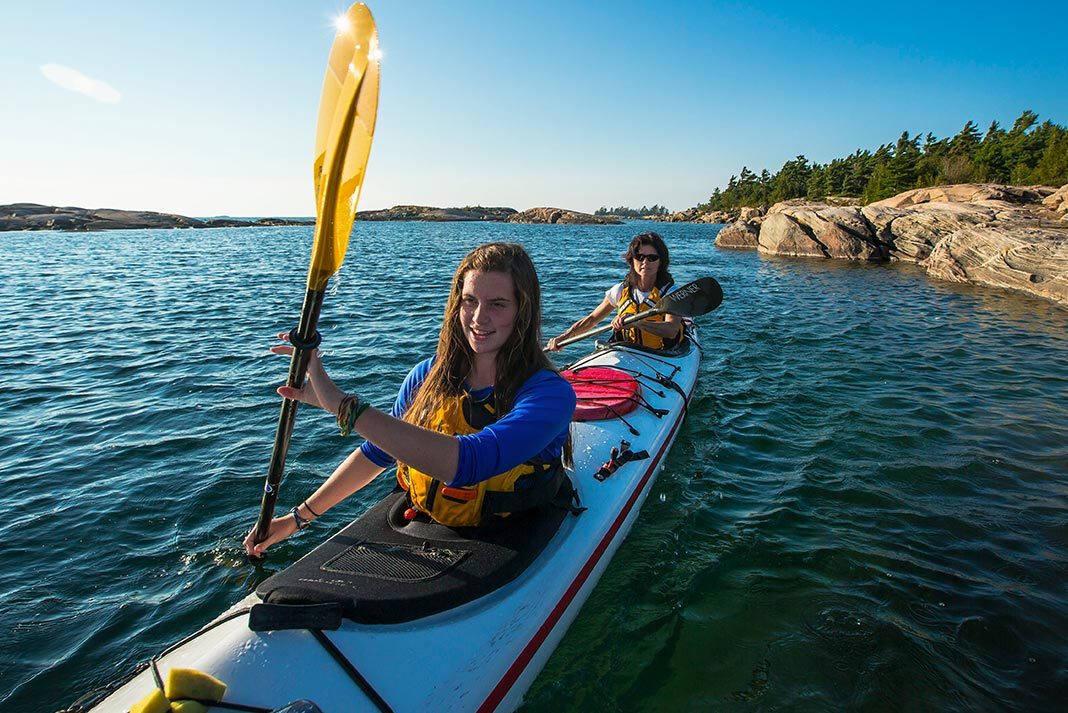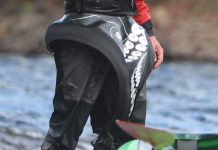If you’re new to kayaking, you may keep hearing the word skirt or sprayskirt. And you may be wondering, what is a kayak skirt? Depending on the kayaking you’re doing, a kayak skirt can be an essential piece of gear.
How does a kayak skirt work? Well, when you sit in the cockpit of your kayak without a skirt, there is an open space between your body and the kayak shell. If you end up in any kind of rough water, this is where your vessel will take on water. With water in your boat, you’ll lose buoyancy, which will make the boat capsize easier. And if the water is cold, it’ll take all the fun out of kayaking.
The kayak skirt essentially seals this hole, making you and your kayak one solid piece of gear and preventing the majority of the water from getting into your boat.
Do I need a sprayskirt for my kayak?
Whether you need a kayak skirt or not really depends on the kind of kayaking you’re doing. If you’ll be in warm, sheltered, flatwater lakes for the majority of your paddling, you can get away without one. Likewise, if your kayak is a cottage toy where half the fun is tipping and falling out of the boat to go for a swim, then you’re all good.
If you’re just out for calm sunset paddles, sometimes it’s nice to have a skirt to keep yourself warm and dry, but not entirely necessary. A skirt can also be helpful if you have a couple items in your kayak you want to keep dry.
But if you plan on doing some whitewater runs on a river, exploring the choppy Great Lakes, or touring on the ocean, a skirt will make your kayaking experience a safe and enjoyable one. Any time there are waves, chop, windblown water, or rushing river water, using a skirt is essential. If the water is cresting the bow, it’s coming in your boat. And there is a limited amount of water you can have in your boat before you start getting into trouble.
How to buy a kayak skirt
What size kayak skirt do I need?
Just like buying any kind of gear, there will be an endless number of options when you start looking for a skirt. How do you size a kayak sprayskirt? First off, you’ll need to figure out the size of your cockpit. How do you size a kayak cockpit? Great question. The easiest and most surefire way to do so is by contacting your kayak’s manufacturer. Their website will usually have this information on it; just be sure to find your boat model and size. If you have an obscure kayak you can always just measure the width and length of the cockpit and use these measurements to find the correct skirt.
Secondly, you’ll need to make sure the waist size is correct. Think about what you’ll be wearing while paddling so you get the right size.
The way manufacturers size their skirts varies, but if you go to their website they should have decent sizing charts. When they write about “tunnel size” this is the size of the part of the skirt that goes around your waist, while “cockpit size” is the size of your boat’s cockpit.
Neoprene vs. nylon
Kayak sprayskirts are usually made of either neoprene or nylon. There are pros and cons of each. Recreational and touring kayak skirts are often made of waterproof, breathable nylon. Sometimes they’ll have suspenders, which you can adjust for ventilation. These skirts generally have an elastic drawcord that seals around the rim of the kayak’s cockpit. Nylon skirts aren’t completely water resistant, but are comfortable and practical for less extreme kayaking.
Neoprene is used for whitewater skirts and some touring sprayskirts. Neoprene has a lot of stretch to it and creates a very secure and watertight seal to your boat. Some skirts are reinforced to keep them stiff and attached while being pounded with waves. The one hindrance of neoprene is it can get pretty warm and offers no ventilation.
What to think about
Again, depending on what kind of kayaking you’re doing, the way the skirt attaches to your boat becomes important. Many of the recreational skirts use a draw cord. This makes fitting the skirt a bit easier, but has more chance of letting water in.
Whitewater skirts tend to use what is called a rubber rand—a stiff rubber edge that lies flat under the rim of the cockpit. It’s completely watertight and resists being torn off by moving water. Getting the cockpit sizing right on neoprene skirts is essential because of this tight fit.
Best sprayskirt brands
There are plenty of brands manufacturing kayak skirts these days, but the following are some of the best when it comes to quality and functionality:
- Advanced Elements
- Delta Kayaks
- Level Six
- North Water
- Perception Kayaks
- Wilderness Systems
Kayak skirt reviews
Here are a few sprayskirts our team at Paddling Magazine has reviewed:
How to put on a kayak skirt
The first time you put on a kayak skirt it may seem like the most difficult thing in the world. But it’ll get easier with time and practice. First, with your paddling wear and PFD on, you step into the skirt and get it roughly situated and tightened on your waist. Then you step into the boat.
Sitting in the boat, you’ll need to get the skirt under the rim of the boat behind you. It’ll feel like you’re doing some kind of painful yoga, but you’ll get it. Once it is under the rim at the back, use both hands to push the skirt under the cockpit rim, moving both hands forward (right hand on the right side, left hand on the left side), and work your way slowly up to the front. Be sure the grab handle is on top of the skirt when you get the final few inches at the front of the skirt under the rim. Then tighten up any suspenders or waist adjustments until you’re comfortable.
How to make a kayak skirt
If you’re the DIY type, then you may be wondering about a DIY kayak skirt. And yes, of course you can make your own. You’ll need some sewing skills and sewing equipment, and you’ll need to source your own materials. Whether the time and effort involved will save you any money is totally debatable, but we too love a good challenge.
There may be better resources out there to get this done, but a quick search found these two resources:
- Re: Make Your Own Nylon Sprayskirt (Kayak Forum)
- Making Your Own Spray Skirt (California Kayak Friends)
Good luck!








Two comments: 1) Water in a kayak will affect the buoyancy of the boat, but air trapped in waterproof stuff sacks will help boat retain flotation and the more gear the less room for water to fill; 2) water sloshing around in a kayak affects the center of gravity of the boat by always moving as the weight of the water moves about the cockpit/interior of the boat. Buoyancy AND Center of Gravity are vital. Also, it’s best to learn how to go all the way over in a capsize rather than try to scramble out of the boat immediately upon tipping beyond the righting point. Paddlers too often rip off the spray skit as soon as they lose their balance and as they scramble out of the overturning boat, water is spilling into the cockpit, filling the kayak before it’s even all the way over. Better to take a deep breath, roll all the way over and assuming you don’t have a roll, exit the cockpit (practicing doing this in a pool to fine tune the fit of your spray skirt) and return to the surface. The air pressure inside the cockpit will keep most water from entering. You can then do one of several water draining/righting techniques to get your boat back up without getting too much water in the cockpit. All these efforts should be practiced in a pool to learn all the challenges of these types of self-rescue/re-entry techniques. Be Safe/Be Smart/Have Fun!
We wear our PFD’s over our skirt tunnels. Is everyone in our group doing it incorrectly?
You are correct! If the tunnel has any rise it will have to go under the PFD. Only the most simple spray skirt with little ability to seal at your waist could even go on after the PFD. My dry suit has a special skirting on it to go over the top of the skirt as well – no way could you arrange that with the PFD on.
Tom makes good points. One more, especially important for whitewater or rougher sea kayaking: always put your sprayskirt on *before* you don your PFD. The tunnel of the skirt always goes *under* the PFD — depending on the skirt, it might reach as high as your chest — and it’s pretty darn tricky to get it under there if you’ve already got your PFD all cinched up.
Hey Folks, I enjoy the magazine. I just want to flag two problematic things in the recent article offering advice about buying and using spray skirts. One, the article talks about how difficult it can be to stretch and secure a whitewater skirt with a thick rubber rand around the cockpit rim, but fails to mention the option of getting a skirt with a bungee/shock cord. Bungees are much easier to stretch, and work great in all but the most extreme conditions — assuming quality construction and proper sizing. There is no need for a beginner to struggle with a rand skirt if they find it hard to put on the boat. Two, the article says when putting on a sprayskirt: “First, with your paddling wear and PFD on, you step into the skirt …”. Sheesh. Given pfds are properly worn over top of spray skirts this is an unfortunate bit of advice to offer an aspiring kayaker.
Snapdragon is not on your list but should be. A small company that makes a great product both whitewater and sea kayak that can be customized to the individual paddler.
Here! Here! for Snapdragon spray skirts….used them for decades! Also want to mention, practice capsizing and releasing your skirt in protected waters (pool) to learn how easy it is. Also, consider learning how to re-attach it while overturned as there are several rescues that will enable you to be righted again with you in the cockpit. If you fell out you can do a “skin-the-cat” maneuver back into the cockpit, attach the skirt and take the assist roll back to the surface…You DO have to be able to hold your breath for about 15 seconds through all this.
When I bought my spray skirt they also looked up the distance of the tunnel from the back – so 3 measurements. Also, never use a spray skirt until you are comfortable removing it while over turned (the so called “wet exit”). Pretty easy but you do not want to be “learning” it while overturned in cold water with no visibility. Put your hands on the coming and slide them forward to the pull tab (which you double checked was not pinched under the elastic rand when you put it on). Then pull and you will automatically fall out. One more thing – depending on how you enter (either at water’s edge or in a reentry in deep water) it is easy to end up sitting on the part of the spray skirt behind you. It is hard to get it unstuck from under you without tipping – especially if your boat is full of water. As you enter, take a second and make a habit of flipping it up so you do not sit on it. You will remember to do this after you have accidentally sat on it a couple of times. Don’t ask me how I know!
Other top spray skirt brands are 1) Immersion Research (aka “IR”), 2) Seals, and 3) Reed Chillcheater (a UK company). Unfortunately unless something has recently changed for the better, SnapDragon closed shop about 6 months ago..